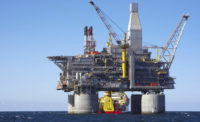 Noise pollution at oil and gas sites remains “woefully under-studied contrary to its public health significance,” according to the Natural Resources Defense Council (NRDC).
Noise pollution at oil and gas sites remains “woefully under-studied contrary to its public health significance,” according to the Natural Resources Defense Council (NRDC).
Environmental noise caused by oil and gas drilling activities is often overlooked entirely or rejected as a minor, temporary nuisance by industry and regulators, despite the fact that drilling and other activities at well sites are very noisy and can be close to homes, according to the NRDC.
Public health experts say noise is a ubiquitous health threat for communities near oil and gas development sites, and studies have found noise levels above safety thresholds, according to the NRDC. Insufficient steps have been taken to reduce noise levels, says the environmental group.
To combat environmental noise, the EPA has specified guideline values of annual 24-hour averages of 45 dB indoors and 55 dB in outdoor environments. The agency states that lifetime exposure (continuous exposure for 70 years) to noise above 70 decibels in a 24-hour period may lead to hearing loss.
OSHA’s occupational permissible noise exposure limits specify maximum periods of time workers can be exposed to different noise levels. At 90 dBA exposure is limited to a maximum of 8 hours per day; at 115 dBA exposure duration must be at most 15 minutes.
Unconventional oil and gas development, including the use of hydraulic fracturing, are industrial processes that generate prolonged periods of noise pollution for workers and nearby communities, according to the NRDC. Noise from trucks, generators, drilling operations, and pumpscan occur intermittently for days at a time and throughout several years as wells are hydraulically fractured and reworked many times, according to the group. The more recent practice of drilling multiple wells per well pad at higher well density can further increase the duration, frequency, and intensity of noise pollution, the group says.
A lack of measurement data at and near drilling sites currently exists, according the NRDC. A 2006 study for the City of Fort Worth in Texas found drilling noise was audible at 700 feet from the wellbore and drilling brakes could be heard at 1,000 feet. The average noise level at 200 feet was between 71-79 dBA. The loudest noise at 102 dBA, measured at 10 feet, was caused by rig generators.
New York State’s 2011 draft Supplemental Generic Environmental Impact Statement on the proposed regulations regarding high-volume hydraulic fracturing estimated noise levels would range from 52 to 75 dBA during well pad construction, 44 to 68 dBA during drilling, and 72 to 90 dBA during high=volume hydraulic fracturing – all at a distance of 250-2,000 feet. At 50 to 500 feet, hydraulic fracturing noise could reach 102 dBA.
To expand and strengthen noise standards and to bring relief to impacted communities, NRDC says the following steps are necessary:
- Assessments of the health impacts of noise at and near oil and gas development, including fracking,
- Research into characterizing noise pollution in the vicinity of unconventional oil and gas well sites in terms of its sources, intensities, frequencies, and duration,
- Increase noise monitoring at and near unconventional oil and gas development sites,
- Adequate setback distances to minimize noise impacts on communities affected by oil and gas development,
- Federal assessment and regulations of noise need to be updated to reflect current research and increased threats from expanding sectors, like oil and gas,
- Strengthened state and local laws and ordinances requiring operators to submit noise management plans with their drilling permit applications.



